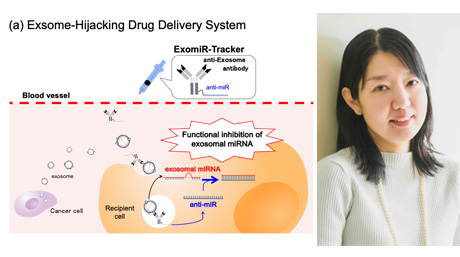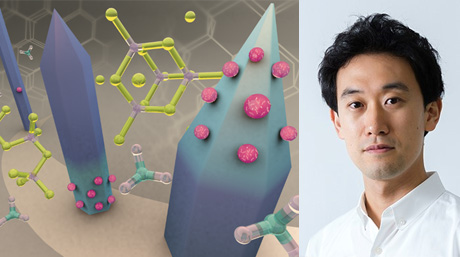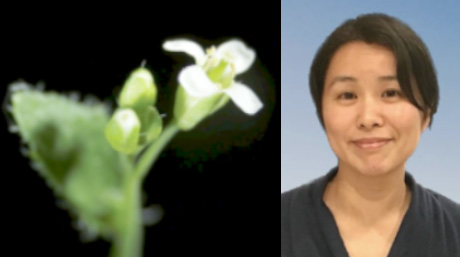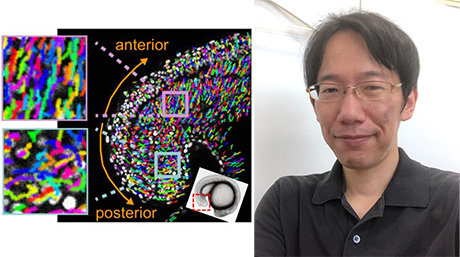Life Science and Technology News
【Labs spotlight】 Tokunaga and Sogawa Laboratory(~2025.3)
Visualization and quantitation of cell mechanisms
The Department has a variety of laboratories for Life Science and Technology, in which cutting-edge innovative research is being undertaken not only in basic science and engineering but also in the areas of medicine, pharmacy, agriculture, and multidisciplinary sciences.
This "Spotlight" series features a laboratory from the Department and introduces you to the laboratory's research projects and outcomes. This time we focus on Tokunaga and Sogawa Laboratory.
※Associate Professor Sogawa was retired on March 31, 2017, as she reached the mandatory retirement age.
※Professor Tokunaga was retired on March 31, 2025, as she reached the mandatory retirement age.
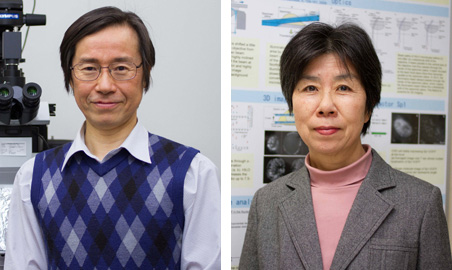
Life Science and Technology
Professor Makio Tokunaga![]() and Associate Professor Kumiko Sakata-Sogawa
and Associate Professor Kumiko Sakata-Sogawa
| Degree | Professor Makio Tokunaga : PhD 1987, The University of Tokyo Associate Professor Kumiko Sakata-Sogawa : PhD 2000, Tohoku University |
|---|---|
| Areas of Research | Professor Makio Tokunaga : Biophysics, Microscopy, Cell biology Associate Professor Kumiko Sakata-Sogawa : Biophysics, Immunology, Molecular biology |
| Keywords | Professor Makio Tokunaga : Single-molecule imaging, Transcription, Chromatin-remodeling, Super-resolution microscopy Associate Professor Kumiko Sakata-Sogawa : Single-molecule imaging, Transcription, Chromatin-remodeling, Immune response |
| Website | Tokunaga and Sogawa Laboratory |
Research interest
Professor Makio Tokunaga
Based on emerging techniques in molecular imaging, our long-term goal is the understanding of transcriptional regulation related to cell signaling. To achieve this goal, we quantify the interactions of signaling molecules, transcriptional regulators and chromatin.
Integrated quantitative analysis of molecular dynamics and interactions
Many research programs focus on the molecular dynamics of living cells. This research requires not only visualizing individual molecules but also quantifying molecular dynamics and interacions. Thanks to the development of better fluorescent labeling techniques of bio-molecules in living cells, the target of imaging analysis is being expanded into its spatio-temporal resolution. For example, photo-activatable GFP variants enable labeling of a limited number of proteins, which yields super-resolution images of different protein molecules simultaneously. We are developing an integrated method for quantitative analysis of molecular dynamics and interactions, combining multiple methods of microscopy. Integrated use of multi-color single-molecule imaging, single molecule tracking, super-resolution microscopy, fluorescence recovery after photobleaching (FRAP) and/or fluorescence cross-correlation spectroscopy (FCCS) provides a means to obtain new kind of spatio-temporal or kinetic parameters on molecular dynamics and interactions.
Dynamic chromatin structure and function to understand fundamentals of life
Why do the same genes accomplish a great variety of functions and structures? This is one of the most important subjects in the life science. Chromatin, a molecular structure storing genetic information composed of DNA and proteins, plays a vital role in not only genetic activities but also biological functions. Recent studies revealed that its structure is not invariable but spatio-temporally variable in response to functions. This dynamic structural change of the chromatin is the basis of the biological functions and activities.
We are now focusing on elucidating this subject related with signal transduction, transcription regulation, chromatin remodeling using molecular imaging and quantitative analysis.
Associate Professor Kumiko Sakata-Sogawa
When cells are subjected to an extracellular signal, a specific receptor on the cell surface is activated. This activation triggers signaling cascades and results in modulation of gene expression in the nucleus, causing a response to the environment. Gene expression is strictly controlled to ensure the cells produce the correct amount of proteins when needed. Transcription is a first step of gene expression, and orchestrated by various protein factors, such as transcription machinery proteins and transcription factors, Chromatin-remodeling is also an important process to regulate transcription by the dynamic modification of chromatin architecture.
Aiming to understand how the transcription factors regulate the function of transcription machinery proteins, we develop single molecule imaging system and observe the events in the nucleus of living cells. We are also interested in the regulation of immune response by transcription factors.
Research result
Selected publications
Professor Makio Tokunaga
- [1] Ito Y, Sakata-Sogawa K, Tokunaga M.: A Facile Preparation of Glass-supported Lipid Bilayers for Analyzing Molecular Dynamics.: Anal Sci, 30 (12), 1103-1106, 2014. PMID: 25492457 selected as Hot Article Award
- [2] Stasevich TJ, Hayashi-Takanaka Y, Sato Y, Maehara K, Ohkawa Y, Sakata-Sogawa K, Tokunaga M, Nagase T, Nozaki N, McNally JG, Kimura H:: Regulation of RNA polymerase II activation by histone acetylation in single living cells. Nature 516 (7530), 272-275, 2014. PMID: 25355676
- [3] Yokosuka T., Kobayashi W., Takamatsu M., Sakata-Sogawa K., Zeng H., Hashimoto-Tane A., Yagita H., Tokunaga M., Saito T.: Spatiotemporal basis of ctla-4 costimulatory molecule-mediated negative regulation of T cell activation. Immunity 33, (3) 326-339, 2010. PMID: 20870175
- [4] Shiina N, Yamaguchi K, Tokunaga M.: RNG105 Deficiency Impairs the Dendritic Localization of mRNAs for Na+/K+ ATPase Subunit Isoforms and Leads to the Degeneration of Neuronal Networks. J. Neuroscience, 30 (38), 12816-12830, 2010. PMID: 20861386
- [5] Fukagawa A., Hiroshima M., Sakane I., Tokunaga M.: Stochastic emergence of multiple intermediates detected by single-molecule quasi-static mechanical unfolding of protein., BIOPHISICS 5, 25-35, 2009. PMID: 19139567
- [6] Yokosuka T., Kobayashi W., Sakata-Sogawa K., Takamatsu M., Hashimoto-Tane A., Dustin ML., Tokunaga M., Saito T.: Spatiotemporal regulation of T cell costimulation by TCR-CD28 microclusters and protein kinase C theta translocation. Immunity, 29(4), 589-601, 2008. PMID:18848472
- [7] Tokunaga M., Imamoto N., Sakata-Sogawa K.: Highly inclined thin illumination enables clear single-molecule imaging in cells. Nat Methods, 5(2), 159-161, 2008. PMID:18176568
- [8] Yamasaki S., Sakata-Sogawa K., Hasegawa A., Suzuki T., Kabu K., Sato E., Kurosaki T., Yamashita S., Tokunaga M., Nishida K., Hirano T.: Zinc is a novel intracellular second messenger. J. Cell. Biol., 177(4), 637-645, 2007. PMID:17502426
- [9] Yamasaki S., Ishikawa E., Sakuma M., Ogata K., Sakata-Sogawa K., Hiroshima M., Wiest DL., Tokunaga M., Saito T.: Mechanistic basis of pre-T cell receptor-mediated autonomous signaling critical for thymocyte development. Nat. Immunol., 7(1), 67-75, 2006. PMID:16327787
- [10] Shiina N., Shinkura K., Tokunaga M.: A novel RNA-binding protein in neuronal RNA granules: Regulatory machinery for local translation. J.Neuroscience, 25 (17), 4420-4434, 2005. PMID: 15858068
- [11] Yanagida T., Esaki S., Iwane A.H., Inoue Y., Ishijima A., Kitamura K., Tanaka H., Tokunaga M.: Single-motor mechanics and models of the myosin motor. Philos. Trans. R. Soc. Lond. B Biol Sci, 355, 441-447, 2000. PMID: 10836497
- [12] Kitamura K., Tokunaga M., Iwane A. H. & Yanagida T.: A single myosin head moves along an actin filament with regular steps of 5.3 nanometres. Nature, 397, 129-134, 1999. PMID: 9923673
Associate Professor Kumiko Sakata-Sogawa
- [1] Ito Y., *Sakata-Sogawa K., *Tokunaga M.: A facile preparation of glass-supported lipid bilayers for analyzing molecular dynamics. Analytical Sciences 30 (12), 1103-1106, 2014. PMID: 25492457
- [2] Stasevich TJ, Hayashi-Takanaka Y, Sato Y, Maehara K, Ohkawa Y, Sakata-Sogawa K, Tokunaga M, Nagase T, Nozaki N, McNally JG, and *Kimura H.: Regulation of RNA polymerase II activation by histone acetylation in single living cells. Nature 516, 272-275, 2014. PMID: 25355676
- [3] Hashimoto-Tane A. ,Yokosuka T., Sakata-Sogawa K., Sakuma M., Ishihara C., Tokunaga M., *Saito T.: Dynein-driven transport of T cell receptor microclusters regulates immune synapse formation and T cell activation. Immunity, 34, 919-931, 2011. PMID: 21703543
- [4] Yokosuka T., Kobayashi W., Takamatsu M., Sakata-Sogawa K., Zeng H., Hashimoto-Tane A., Yagita H., Tokunaga M., *Saito T.: Spatiotemporal basis of ctla-4 costimulatory molecule-mediated negative regulation of T cell activation. Immunity 33, (3) 326-339, 2010. PMID: 20870175
- [5] Yokosuka T., Kobayashi W., Sakata-Sogawa K., Takamatsu M., Hashimoto-Tane A., Dustin ML., Tokunaga M., and *Saito T.: Spatiotemporal Regulation of T Cell Costimulation by TCR-CD28 Microclusters and Protein Kinase CθTranslocation. Immunity 29, 589-601, 2008. PMID: 18848472
- [6] *Tokunaga, M., Imamoto, N., Sakata-Sogawa, K.: Highly inclined thin illumination enables clear single-molecule imaging in cells. Nature Methods. 5, (2) 159-161, 2008. PMID: 18176568
- [7] Yamasaki, S., Sakata-Sogawa, K., Hasegawa, A., Suzuki, T., Kabu, K., Sato, E., Kurosaki, T., Yamashita, S., Tokunaga, M., Nishida, K., *Hirano, T.: Zinc is a novel second messenger. J. Cell Biol. 177, 637-645, 2007. PMID: 17502426
- [8] Yamasaki S., Ishikawa, E., Sakuma, M., Ogata, K., Sakata-Sogawa K., Hiroshima, M., Wiest, D. L., Tokunaga M., *Saito, T.: Mechanistic basis of pre-T cell receptor-mediated autonomous signaling critical for thymocyte development. Nature Immunol. 7, 67-75, 2006. PMID: 16327787
- [9] Yokosuka T., Sakata-Sogawa K., Kobayashi, W., Hiroshima, M., Hashimoto-Tane, A., Tokunaga M., Dustin, M. L., *Saito, T.: Newly generated T cell receptor microclusters initiate and sustain T cell activation by recruitment of Zap70 and SLP-76. Nature Immunol. 6, 1253-1262, 2005. PMID: 16273097
- [10] Sakata-Sogawa, K., *Shimamoto, N.: RNA polymerase can track a DNA groove during promoter search. Proc. Natl. Acad. Sci. USA 101(41), 14731-14735, 2004. PMID: 15469913
- [11] *Sakata-Sogawa K, Kurachi M, Sogawa K, Fujii-Kuriyama Y, Tashiro H.: Direct measurement of DNA molecular length in solution using optical tweezers: detection of looping due to binding protein interactions. Eur Biophys J. 27(1):55-61, 1998. PMID: 9463890
Contact
Professor Makio Tokunaga
Room 511, B1 building, Suzukakedai campus
Email mtoku@bio.titech.ac.jp
*Find more about the lab and the latest activities at the lab site![]() (Japanese).
(Japanese).

